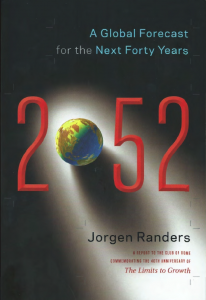I fina lly got around to 2052: A Global Forecast for the Next Forty Years by Jorgen Randers. Randers has been part of the three Limits to Growth Books: the original in 1972, and then the 20 and 30 year updates. In those works, the authors stuck to the models and the data and presented their results as analysts. In 2052, Randers deliberately sought to provide his personal view of the most likely future, albeit informed by the models and data. I had the opportunity to meet Randers when he part of Dow Chemical’s Environmental Advisory Board when I working there back in the early 2000s. He is a delightful person to work with, but he was quite blunt and rather pessimistic about the future back then. So, I was intrigued to see what he would say with the gloves off, so to speak.
lly got around to 2052: A Global Forecast for the Next Forty Years by Jorgen Randers. Randers has been part of the three Limits to Growth Books: the original in 1972, and then the 20 and 30 year updates. In those works, the authors stuck to the models and the data and presented their results as analysts. In 2052, Randers deliberately sought to provide his personal view of the most likely future, albeit informed by the models and data. I had the opportunity to meet Randers when he part of Dow Chemical’s Environmental Advisory Board when I working there back in the early 2000s. He is a delightful person to work with, but he was quite blunt and rather pessimistic about the future back then. So, I was intrigued to see what he would say with the gloves off, so to speak.
 The best way I can think to sum up the forecast is the boiling frog, gradual decline without major catastrophe. In Houston Foresight terms, it is an extended baseline that gradually morphs into a stagnation version of collapse. Let me translate. The baseline is the continuity future of present trends continued and no major surprises. Collapse is a scenario archetype or pattern in which the current system, well, collapses. I’ve been thinking that we ought to rename collapse to “dysfunction,” because collapse creates an image of the Mad Max apocalypse, but in reality it is more like stagnation. The system stops working, and efforts to fix it don’t work, and things just meander along at a low level of functionality. Think of Japan’s long period of stagnation, with flat or negative economic growth.
The best way I can think to sum up the forecast is the boiling frog, gradual decline without major catastrophe. In Houston Foresight terms, it is an extended baseline that gradually morphs into a stagnation version of collapse. Let me translate. The baseline is the continuity future of present trends continued and no major surprises. Collapse is a scenario archetype or pattern in which the current system, well, collapses. I’ve been thinking that we ought to rename collapse to “dysfunction,” because collapse creates an image of the Mad Max apocalypse, but in reality it is more like stagnation. The system stops working, and efforts to fix it don’t work, and things just meander along at a low level of functionality. Think of Japan’s long period of stagnation, with flat or negative economic growth.
My take on the Limits to Growth works has been that it has been consistently on target and that critics have missed the really long timeframe of their model. That said, surely by 2052, the collapse would happen, assuming we don’t take the appropriate measures…right? So, I expected that Randers would be telling the unfiltered story of collapse.
Not exactly. His view is that we can continue to muddle through to 2052, with things generally getting worse, but some (i.e., the wealthier) doing okay. It’s beyond 2052 that things may get to the apocalyptic crash level, e.g., self-reinforcing warming, but even here Randers believe that the worst is not most likely…that we will do just enough to get avoid the worst.
I am not sure how I feel about this. Part of me thinks that this boiling frog version of the future is terrible news. It’s already happening – things are slowly degrading, but not enough to stimulate a serious response. I know many futurists believe that there needs to be some sort cataclysmic event to rally the public to change and move towards a more preferable future. Some still hold out het possibility that this change can happen without the cataclysm.
I think Randers’ work provides us a very valuable cautionary tale that we may have to get used to the idea that today’s baseline, which many futurists (and non-futurists) believe is bound to explode, maybe with us for quite some time. What is our strategy for social change in a boiling frog scenario? – Andy Hines

Leave a Reply